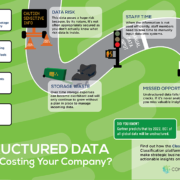Whether in traditional formats such as paper in a file cabinet, digitally stored in local drives, or remotely stored with a cloud provider, sensitive data for an organization, their staff, and their clients are likely to be found within them. When a security plan is not adequately enforced to locate, classify, and protect that sensitive data, the potential breach that can follow can lead to identity theft that jeopardizes an organization’s trust, whether from their staff, their clients, or the public at large.
Educational institutions and the third-party entities that help manage their data often possess and obtain sensitive student data as part of their operations. The need to keep that data in legal compliance and to maintain student privacy with its use means extra care and maintenance must be done to prepare the data for a cloud migration.
Data security has become more important than ever in 2022. Due to the increase in data breaches over the years, data security for sensitive information has become a more prevalent issue for both regulatory requirements, such as GDPR, and customer trust, who will essentially avoid doing business with companies they don’t trust with their personal data. Confidential information for organizations is also commonly stored as data, which in turn requires effective data security to protect both trade secrets and the bottom line.
When it comes to unstructured data in an organization, sensitive data is the most important type of data to identify. Sensitive data falls into several classifications, but broadly refers to data that must be protected from unauthorized access to prevent harm to businesses and individuals alike. These classifications include personal information, private information, health information, and high-risk data, among others.
The cloud-first priority shift is one of the biggest transformative changes impacting businesses as a result of Covid-19. According to Gartner, by 2024 more than 45% of IT spending on system infrastructure, infrastructure software, application software and business process outsourcing will shift from traditional solutions to cloud. And by 2025, 85% of large enterprises will have a cloud-first principle.
Unstructured data, as you might guess, is any type of data that can’t be easily organized into your typical database or spreadsheet. These are the pieces of content that you come across every day. They exist in emails and social media. You might run across this information in webinars or conference calls. Your call centers get unstructured data in the form of verbal communications.
Cloud computing is one of the top three game-changing technologies, meaning many organizations regardless of size, industry, and technology will begin or increase their usage of the cloud. With that being said, according to Gartner’s most recent report, “through 2024, 80% of companies unaware of mistakes made by organizations in their cloud adoption will overspend in cloud by 20% to 50%.”











